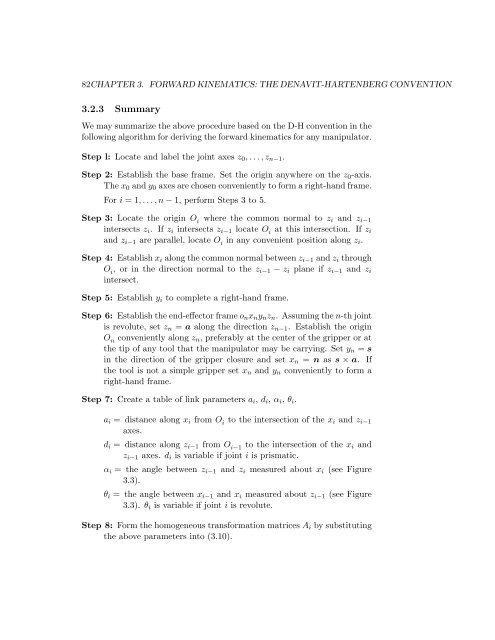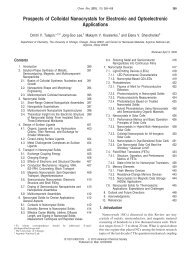FORWARD KINEMATICS: THE DENAVIT-HARTENBERG ...
FORWARD KINEMATICS: THE DENAVIT-HARTENBERG ...
FORWARD KINEMATICS: THE DENAVIT-HARTENBERG ...
You also want an ePaper? Increase the reach of your titles
YUMPU automatically turns print PDFs into web optimized ePapers that Google loves.
82CHAPTER 3. <strong>FORWARD</strong> <strong>KINEMATICS</strong>: <strong>THE</strong> <strong>DENAVIT</strong>-<strong>HARTENBERG</strong> CONVENTION<br />
3.2.3 Summary<br />
We may summarize the above procedure based on the D-H convention in the<br />
following algorithm for deriving the forward kinematics for any manipulator.<br />
Step l: Locate and label the joint axes z0,...,zn−1.<br />
Step 2: Establish the base frame. Set the origin anywhere on the z0-axis.<br />
The x0 and y0 axes are chosen conveniently to form a right-hand frame.<br />
For i = 1,...,n − 1, perform Steps 3 to 5.<br />
Step 3: Locate the origin O i where the common normal to zi and zi−1<br />
intersects zi. If zi intersects zi−1 locate O i at this intersection. If zi<br />
and zi−1 are parallel, locate O i in any convenient position along zi.<br />
Step 4: Establish xi along the common normal between zi−1 and zi through<br />
O i , or in the direction normal to the zi−1 − zi plane if zi−1 and zi<br />
intersect.<br />
Step 5: Establish yi to complete a right-hand frame.<br />
Step 6: Establish the end-effector frame onxnynzn. Assuming the n-th joint<br />
is revolute, set zn = a along the direction zn−1. Establish the origin<br />
O n conveniently along zn, preferably at the center of the gripper or at<br />
the tip of any tool that the manipulator may be carrying. Set yn = s<br />
in the direction of the gripper closure and set xn = n as s × a. If<br />
the tool is not a simple gripper set xn and yn conveniently to form a<br />
right-hand frame.<br />
Step 7: Create a table of link parameters ai, di, αi, θi.<br />
ai = distance along xi from O i to the intersection of the xi and zi−1<br />
axes.<br />
di = distance along zi−1 from O i−1 to the intersection of the xi and<br />
zi−1 axes. di is variable if joint i is prismatic.<br />
αi = the angle between zi−1 and zi measured about xi (see Figure<br />
3.3).<br />
θi = the angle between xi−1 and xi measured about zi−1 (see Figure<br />
3.3). θi is variable if joint i is revolute.<br />
Step 8: Form the homogeneous transformation matrices Ai by substituting<br />
the above parameters into (3.10).
















